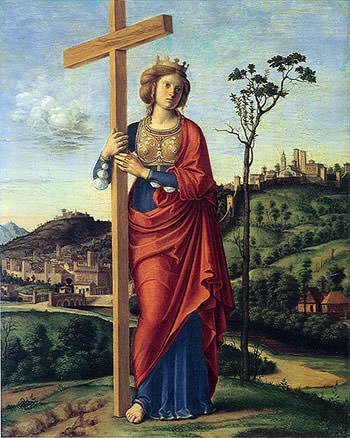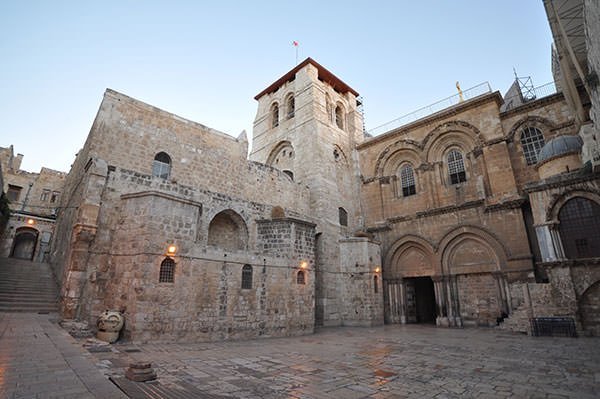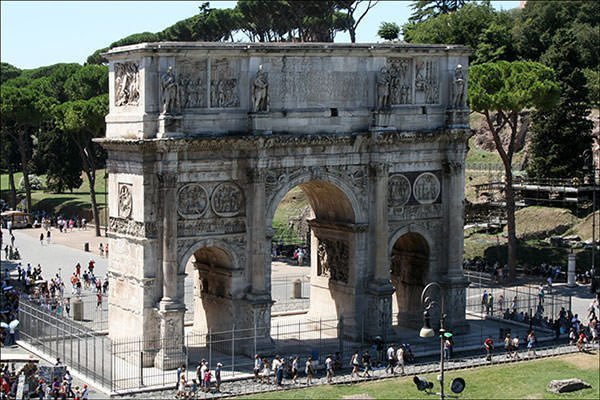Constantine I, who came to be known as Constantine the Great, was a Roman Emperor at the beginning of the 4th century, who won several important battles to reunite the Roman Empire under one emperor after decades of internal conflict. But Constantine is most famous for laying the foundation for Christianity to become the dominant religion in Europe. Know more about the life, reign, accomplishments, death and contribution to Christianity of Constantine the Great through these 10 interesting facts.
#1 HE WAS THE SON OF CONSTANTIUS CHLORUS AND ST. HELENA
Constantine I was born Flavius Valerius Constantinus around 280 AD in the city of Naissus in the province of Moesia, what is now the city of Niš in southern Serbia. At the time of his birth Constantine’s father Constantius I, also known as Constantius Chlorus, was a military officer in the Roman army. Constantine’s mother Helena was his consort. Due to her influence over her son, Helena played an important part in placing Christianity at the heart of Western Civilization. She is revered as a saint.

#2 HE RECEIVED HIS FORMAL EDUCATION AT THE COURT OF DIOCLETIAN
In 289 AD, Constantius Chlorus left Helena to marry Theodora, stepdaughter of Maximian, who had been recently appointed co-emperor by Roman Emperor Diocletian. In March 293 AD, Diocletian established a system of Tetrarchy by appointing two Caesars (junior emperors); and Constantius Chlorus was appointed as Maximian’s Caesar. Being the primary candidate for future appointment as Caesar, Constantine was sent to the court of Diocletian, where he received a formal education learning Latin literature, Greek, and philosophy. Here he witnessed Diocletian’s “Great Persecution”, the most severe persecution of Christians in Roman history.

#3 CONSTANTINE BECAME EMPEROR AFTER THE DEATH OF HIS FATHER
After the retirement of Diocletian and Maximian in May 305 AD, Constantius was promoted to Augustus. After the death of his father on July 25, 306 AD, Constantine’s supporters proclaimed him as Augustus, though Galerius, who was Augustus at the time, granted him the title of Caesar. Constantine’s share of the Roman Empire consisted of Britain, Gaul, and Spain. In 308 AD, Licinius, a close friend of Galerius, was also appointed Augustus. In 310 AD, Maximian, who had come out of retirement, rebelled against Constantine. He was captured and forced to commit suicide by Constantine in July 310. By mid-311 AD, Constantine, Licinius and Maximian’s son Maxentius were the major powers in Rome.

#4 HE DEFEATED MAXENTIUS IN THE FAMOUS BATTLE OF THE MILVIAN BRIDGE
In 311 AD, Maxentius declared war on Constantine, vowing to avenge his father. In the spring of 312 AD Constantine gathered his force to attack Maxentius. Several towns and cities held by Maxentius surrendered in the next few months and Constantine then marched towards Rome where Maxentius had prepared for a siege. However, Maxentius believing that he was prophesied to win advanced to meet Constantine on 28 October 312 AD, the sixth anniversary of his reign. In the ensuing Battle of the Milvian Bridge, Constantine the Great decisively defeated Maxentius, who drowned in the Tiber River during the battle.

#5 HE BECAME THE UNDISPUTED RULER OF WESTERN ROMAN EMPIRE AFTER DEFEATING MAXENTIUS
On 29 October 312, Constantine entered Rome amid popular jubilation. Maxentius’ body was fished out and decapitated. His head was paraded through the streets. Victory over Maxentius gave Constantine undisputed control over the western half of the Roman Empire with the eastern half ruled by Licinius, who became Constantine’s brother in law in 313 AD. The same year Constantine and Licinius issued the Edict of Milan, which made Christianity an officially recognized and tolerated religion in the Roman Empire. It also granted Christians restoration for all property seized from them during Diocletian’s persecution.

#6 CONSTANTINE BECAME THE SOLE EMPEROR OF THE ROMAN EMPIRE IN 324 AD
The relations between Constantine and Licinius began to deteriorate after an assassination attempt on Constantine by a man Licinius wanted to be Caesar and over Licinius restarting to oppress Christians. This led to the great civil war of 324. Constantine won a series of victories and finally forced Licinius to surrender after defeating him at the Battle of Chrysopolis. Though Constantine initially spared the life of his brother in law, Licinius was later executed on suspicion of treasonable actions. By defeating Licinius, Constantine became the sole Emperor of the Roman Empire.
#7 HE FOUNDED THE CITY OF CONSTANTINOPLE
Constantine’s victory over Licinius marked the rise of Christian and Latin speaking Rome and the decline of Pagan and Greek speaking population. Constantine decided to give the east its own capital. The Greek city of Byzantium was chosen and re-inaugurated in 324 AD. It was dedicated on 11 May 330 and renamed Constantinople or “Constantine’s City”. Constantine considered it his capital and made it his permanent residence. The city became the largest and wealthiest European city and was instrumental in the advancement of Christianity. Today Constantinople lies in Turkey, is known as Istanbul and is the most populous European city.

#8 HE HAD HIS SON CRISPUS AND HIS SECOND WIFE EXECUTED
Constantine’s first wife was Minervina, whom he married in 303 AD. The couple had a son named Crispus. In 307 AD, Constantine left Minervina and married Flavia Maxima Fausta, the daughter of Maximian, to strengthen his position politically. In 326 AD, Constantine had his eldest son Crispus, seized and put to death by “cold poison”. The same year he had his second wife Fausta killed by leaving her to die in an over-heated bath. The reason behind the executions of Crispus and Fausta is not known with certainty. Though an illicit relationship between the two has been proposed, the reason is more likely to be political.

#9 CONSTANTINE WAS INSTRUMENTAL IN THE RISE OF CHRISTIANITY IN EUROPE
Constantine was the first Roman emperor to profess Christianity. He paved the way for it to become the dominant religion of the Roman Empire and ultimately of Europe. He ended the persecutions of Christians and legalised Christianity. While some scholars believe that he adopted his mother Helena’s Christianity in his youth others say that his conversion to Christianity started after his vision of Christ promising him victory at the Battle of the Milvian Bridge. The Church of the Holy Sepulchre in Jerusalem and Old St. Peter’s Basilica in Rome were built on his orders and numerous other churches owed their development directly or indirectly, to Constantine’s interest.

#10 He WAS THE SECOND LONGEST SERVING ROMAN EMPEROR
Constantine fell seriously ill in the spring of 337. He was baptized by Eusebius of Nicomedia on his deathbed. Constantine died on May 22, 337 AD in Ancyrona, near Nicomedia, Bithynia and was buried in Constantinople at the Church of the Apostles. Apart from reuniting Rome, Constantine enjoyed victories against the Franks, Alamanni, the Goths and the Sarmatians. Due to his popularity and accomplishments, 10 succeeding Emperors took his name. Serving for a total of almost 31 years, he was the longest serving emperor since Augustus and the second longest serving emperor in Roman history. For his contribution to Christianity, he is venerated as a saint by Eastern Orthodox Christians, Anglicans, and Byzantine Catholics.

THE ARCH OF CONSTANTINE

Triumphal arches are monumental structures in the shape of an archway which are the most influential type of architecture associated with ancient Rome. Build to commemorate Constantine I’s victory over Maxentius at the Battle of Milvian Bridge, the Arch of Constantine is the largest surviving Roman triumphal arch and the last great monument of Imperial Rome. Though it is among the most famous monuments of its era, it also remains highly controversial due to several reasons including the belief of some historians that it was erected during the reign of Maxentius; the arch being heavily decorated with parts of older monuments; and depictions of Pagan gods and goddesses on the arch despite Constantine’s fervour for Christianity.


A man who had his son killed for Political Fears and his 2nd wife also killed, no longer had a use for her Politically, and erected a huge entry Gate with a Huge Sculpture of himself wearing a Sun Crown (reciprocating the Sun God), and with countless current era Pagan symbols s, etc …
“They make him a Saint”
(Not so much)
He made Christianity a 1 State Religion to satisfy Mom and edited it for Marketability, and to serve as a Tool for his reign. A common practice for managing the masses by Rulers, and as it was the only mass Communication Tool available, at the time. Few could read, and newspapers had yet to be a common media. Paper was yet to be manufactured 8n a cost effective manner, and it was pre printing press.
Whether one likes it or not, the Institutions of the world, that have most public visits are the Tools for managing, particularly when they offer Fear based instructions and a Confessional.
Yeshua/Jesus taught a far higher minded, positive, and with the “Universal Law of Attraction” at it’s foundation, he was intelligent, and contrary to “the edited story”, he came from a very wealthy family, through his Mother, and there exists an abundance of information on him, that was not included in the Bible.
Many of which met their very own established qualifications.
They altered the role of the women whom were era Priests and held equal value in the practice
Yeshua/Jesus was a Rabbi, and he and his Followers, were practicing Judaism. He never indicates establishing a new Religion, he was teaching the greater truths and understandings often referred to as Ancient Knowledge. Often withheld from the Public, but known and practiced by the Elites.
There’s vast more clarity when one focused 9n the History of the Era, applies their Logic, and gains familiarity with the remaining texts, aka Gnostic Gospels.
Or you can rely on a Roman Emperor and his selected Priests.
The Romans loathed the Jews, they had to make changes and make it appeal to a public already happy with Pagan Practices.
This is so cool and thx it help alot
You’re welcome and happy to help.